
21-12-2025 09:32
Hello.A tiny ascomycete found embedded in wood in

21-12-2025 21:32
Pol DebaenstHello, Garden, Burgweg 19, Veurne, BelgiumOn 10/1

22-12-2025 23:38
Patrice TANCHAUDBonsoir, rûˋcolte sur un mur en pierre, apothûˋci

22-12-2025 00:47
Patrice TANCHAUDBonsoir, rûˋcolte û proximitûˋ du milieu dunaire

21-12-2025 21:40
Isabelle CharissouBonjour, j'aimerais connaitre les rûˋfûˋrences de

20-12-2025 23:08
Patrice TANCHAUDBonsoir, rûˋcolte sur sol sablonneux dans l'arriû

20-12-2025 15:47
Mirek GrycHi.These grew on pine wood that was heavily covere
Hymenoscyphus ??
Miguel ûngel Ribes,
27-11-2008 01:16
 Hi again
Hi againSmall apos < 0,5 mm diameter, white, turbinate shape, in a Quercus leave. Spores with 3 septa. Asci eight-spores, IKI +, I think that it have croziers, but I am not completly sure. Paraphysis cylindrical with dextrinoid material at the apex.
Sporal measurement (in water, 1000x)
16.4 [19.4 ; 21.3] 24.3 x 3.2 [3.8 ; 4.2] 4.8
Q = 4 [4.8 ; 5.3] 6.1 ; N = 17 ; C = 95%
Me = 20.35 x 4.03 ; Qe = 5.08
Thanks,
Hans-Otto Baral,
27-11-2008 12:22

Re:Hymenoscyphus ??
Dear Miguel
are your leaves of Quercus ilex? I think you have Calycllina albida (Grelet & Crozals) GalûÀn & Moreno. At the apo-margin this species should have small Phialina-hairs, i.e. with narrowed and partly hooked apical bristle. This is at least the case in a find by Guy Garcia (DVD, HB 7477). Also the spores should have very small polar caps and the ascus apical ring should turn red in concentrated Lugol. But I have seen another collection which does not have these hairs and spore caps, and the asci react blue (HB 6447d). I attach here Guy's specimen.
Zotto
are your leaves of Quercus ilex? I think you have Calycllina albida (Grelet & Crozals) GalûÀn & Moreno. At the apo-margin this species should have small Phialina-hairs, i.e. with narrowed and partly hooked apical bristle. This is at least the case in a find by Guy Garcia (DVD, HB 7477). Also the spores should have very small polar caps and the ascus apical ring should turn red in concentrated Lugol. But I have seen another collection which does not have these hairs and spore caps, and the asci react blue (HB 6447d). I attach here Guy's specimen.
Zotto
Miguel ûngel Ribes,
27-11-2008 22:50

Re:Hymenoscyphus ??
Yes, my leaves are Quercus ilex.
I haven't see Phialina-hairs nor polar caps at the spores. I think I still have fresh material, so I am going to do new check. My specimen fits Ok with the Calycellina albida description in your DVD.
Thanks again
Miguel û. Ribes
I haven't see Phialina-hairs nor polar caps at the spores. I think I still have fresh material, so I am going to do new check. My specimen fits Ok with the Calycellina albida description in your DVD.
Thanks again
Miguel û. Ribes
Hans-Otto Baral,
30-11-2008 23:19

Re:Hymenoscyphus ??
Bingo! Yes, they look just as they must. So I presume Seppo Huhtinen would place this in Phialina but I while not accept that genus as distinct from Calycellina, only because of the hairs. I did not look at the protologue whether these hairs are mentioned, but such small elements are usually overlooked.
Zotto
Zotto
Miguel ûngel Ribes,
01-12-2008 00:06

Re:Hymenoscyphus ??
Hi Zotto
So Callycellina albida is Ok. I forgot to say that in the new samples that I have done with Lugol, again the asci apex are blue, not red.
Thank you very much
So Callycellina albida is Ok. I forgot to say that in the new samples that I have done with Lugol, again the asci apex are blue, not red.
Thank you very much
Hans-Otto Baral,
02-12-2008 16:01

Re:Hymenoscyphus ??
This blue reaction could be either a result of variation of the species which I have seen only once. Or it could ne a matter of the concentration of your lugol. If your lugol looks dark brown in the 10 ccm bottle, then it should have about 1 % iodine. On the preparation you need in some species more than 0.3 % iodine (I2) to get the colour change from blue to red in the case of the RB-reaction (blue at low concentration).
Zotto
Zotto
Miguel ûngel Ribes,
02-12-2008 17:22

Re:Hymenoscyphus ??
With the firsts photos I used IKI 1-3 and now (Phialina hairs) I have used Lugol (solution forte de Nicolle pour mordanûÏage), both of them made by M. Lecomte. This second one has 2 g iodure de potassium and 1 g iode (I attach you the "fiche technique" ). Inside the bottle it looks like dark red-brown.
Thanks again
Thanks again
Hans-Otto Baral,
02-12-2008 20:05

Re:Hymenoscyphus ??
That's o.k. Marcel Lecomte cites two solutions, one with 100, another with 150 ml. I would prefer that with 100 because the iodine slowly disappears over the years, even if in a glass bottle.
Zotto
Zotto
Miguel ûngel Ribes,
02-12-2008 20:31

Re:Hymenoscyphus ??
I think I have too the first one.
Is it better to use this Lugol reactive or IKI 1-3, or IKI 2-6?
Thanks Zotto.
Is it better to use this Lugol reactive or IKI 1-3, or IKI 2-6?
Thanks Zotto.
Hans-Otto Baral,
02-12-2008 21:13

Re:Hymenoscyphus ??
What do you mean with 1-3 and 2-6?
Miguel ûngel Ribes,
02-12-2008 23:20

Re:Hymenoscyphus ??
I don't know exactly because Lecomte hasn't a technical specifications about IKI 1-3 nor IKI 2-6, but a chemist friend of mine thinks the mean is: IKI 1-3 (1% iodine - 3% potassium iodine) and IKI 2-6 (2% iodine - 6% potassium iodine)
Hans-Otto Baral,
03-12-2008 12:17

Re:Hymenoscyphus ??
o.k., if this is so, IKI 1-3 is the normal high-concentrated Lugol solution which I use (Lugol in a restricted sense has only about 0.3% iodine). A 2% solution is quite strong. If one has it, one needs to make quite small drops to the water mount. For lichens 0.3% is better since here the change from blue to red happens often below 0.1%. But 0.3% should be kept in a very large bottle (100 ml or more) to maintain the concentration over a reasonable time of several years.
Zotto
Zotto
Miguel ûngel Ribes,
04-12-2008 00:28

Re:Hymenoscyphus ??
Ok, thank you again.

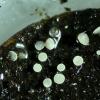
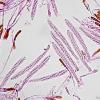
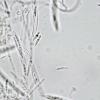
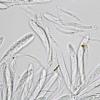
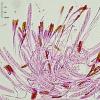
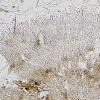
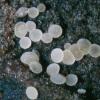
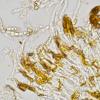
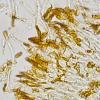
 5906.pdf
5906.pdf